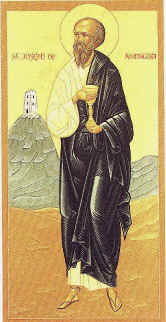
Joseph of Arimathaea
31 July
The Gospels tell us (M 27:57-61; P 15:42-47; L 23:50-56; J 19:38-42) that after the death of Jesus, Joseph of Arimathaea, a wealthy member of the Council, asked Pilate for the body of Jesus, and buried it with honour in the tomb he had intended for himself. This is our only information about him from writers of his own century.
Later tradition has embellished this account. It is said that Joseph was a distant relative of the family of Jesus; that he derived his wealth from tin mines in Cornwall, which he visited from time to time; and that Jesus as a teen-ager accompanied Joseph on one such visit. This is the background of the poem "Jerusalem," by William Blake, which begins:
|
And did those feet in ancient time -- William Blake (1757-1827) |
After the Crucifixion, we are told, Joseph returned to Cornwall, bringing the chalice of the Last Supper, known as the Holy Grail. Reaching Glastonbury, he planted his staff, which took root and blossomed into a thorn tree. The Grail was hidden, and part of the great national epic deals with the unsuccessful quest of the knights of King Arthur to find the Grail. The Thorn Tree remained at Glastonbury, flowering every year on Christmas day, and King Charles I baited the Roman Catholic chaplain of his queen by pointing out that, although Pope Gregory had proclaimed a reform of the calendar, the Glastonbury Thorn ignored the Pope's decree and continued to blossom on Christmas Day according to the Old Calendar.
The Thorn was cut down by one of Cromwell's soldiers on the grounds that it was a relic of superstition, and it is said that as it fell, its thorns blinded the axeman in one eye. A tree allegedly grown from a cutting from the original Thorn survives today in Glastonbury (and trees propagated from it stand on the grounds of the Cathedral in Washington, DC, and presumably elsewhere) and leaves from it are sold in all the tourist shops in Glastonbury.
Has the Glastonbury legend any basis at all in history? Two facts and some speculations follow:
Tin, an essential ingredient of bronze, was highly valued in ancient times, and Phoenician ships imported tin from Cornwall. It is a pretty safe guess that in the first century the investors who owned shares in the Cornwall tin trade included at least a few Jewish Christians.
Christianity gained a foothold in Britain very early, probably earlier than in Gaul. It may have been brought there by the traffic of the Cornwall tin trade. If so, then the early British Christians would have a tradition that they had been evangelised by a wealthy Jewish Christian. If they had forgotten his name, it would be natural to consult the Scriptures to see what mention was made of early wealthy Jewish converts. Joseph and Barnabas are almost the only ones named, and much of the life of Barnabas is already accounted for by the book of Acts, which makes him an unsatisfactory candidate. Hence, those who do not like to be vague would say, not, "We were evangelised by some wealthy Jewish Christian whose name we have forgotten," but, "We were evangelised by Joseph of Arimathaea."
Acknowledgements:
Text adapted from James Kiefer's Christian Biographies
Image from Prismnet (no longer
available)